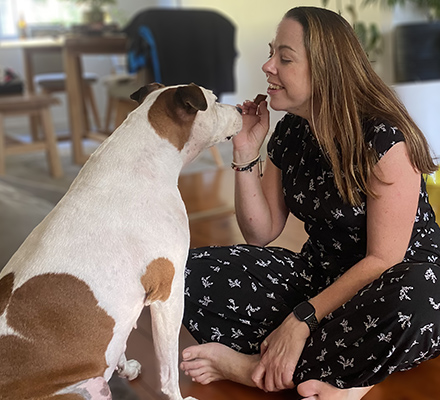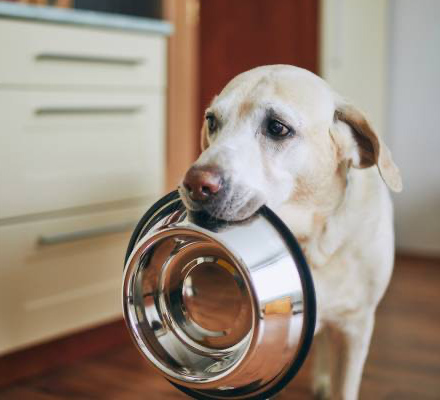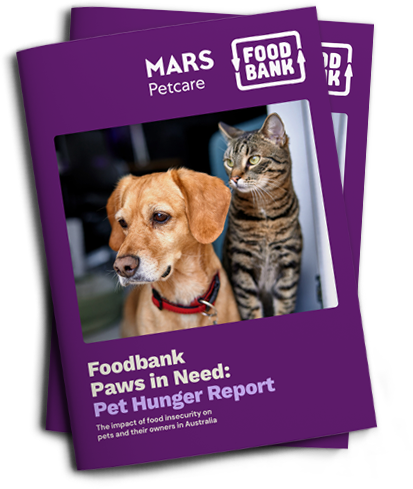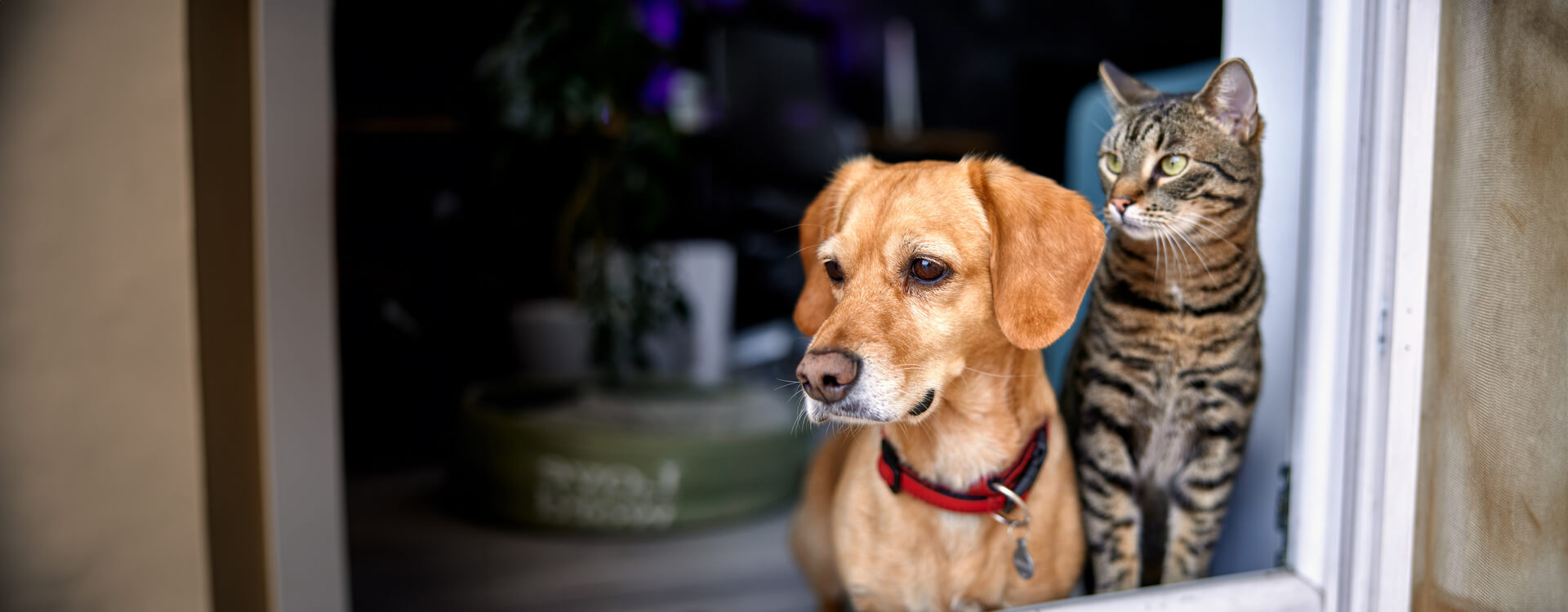
Pets are part of the food insecurity story playing out around Australia
At Foodbank, we are fortunate to have farmers, manufacturers and retailers helping us source essential food and grocery items for food relief, and this also includes pet food for households struggling to feed themselves and their 4-legged family members. Thanks to our valued partner, Mars Petcare Australia, who have supported us with much needed pet-relief for six years, their added support enables us to dig deeper into the prevalence of food insecurity in pet households – an area we have been unable to investigate to date, but one that is extremely important if we are to better understand who we are helping, and more importantly, how we can help.
A message from Brianna Casey, Foodbank Australia CEO“With a much-loved rescue dog joining our family a number of years ago, I can vouch for the important role that pets play in offering companionship, emotional support, routine, and a wide variety of other benefits that positively impact the lives of individuals and families. When times are tough, it’s often our pets that we turn to for unconditional love, an antidote to loneliness and even a sense of purpose. When times are really tough, feeding our pets can be at the cost of feeding ourselves.
Whilst the Foodbank Hunger Report has allowed us to investigate the root causes and prevalence of food insecurity for more than a decade, we have not previously explored how food insecurity presents itself in households with pets. As the findings of this report confirm, compromises and sacrifices are being made, impacting not only the nutrition and wellbeing of people, but so too their pets.”
Brianna Casey
Foodbank Australia CEO
Close panel

Pets are a part of the food insecurity story in Australia
“We had 3 cats and a dog. But we rehomed the dog and the younger cat because they were beginning to become malnourished as we couldn’t afford to feed them all.”
Have you had pets in your household over the last 12 months?
Pet ownership is a significant feature of food insecure households with Foodbank research finding that 56% had pets in the prior 12 months, a prevalence that is higher than the national average of 48%. In the case of food insecure households with children, this figure rises even further with almost two-thirds (64%) having pets in the previous 12 months.
Dogs and cats are the most common pets of choice in Australian households, although a variety of other pets can be found in 39% of households too.
Close panel

Pets play a significant role in supporting households in need
“I am single and live alone, they (pets) provide company. I am also neurodivergent with anxiety, so they help keep me calm and make me feel loved. My dog gets me out of the house as I work from home. So, we walk every day, and I am forced to get outside more because of him.”
“My stepson loves that dog… the pet keeps him focused on the future as he has just recently become a dialysis patient. Without his pet in his 11-year-old life, he would fall into pieces very quickly.”
What were the main reasons you and/or your household decided to get a pet?
Sample (n): 909
The value of pets is widely accepted, but they play an especially crucial role in the lives of food insecure households. They offer valuable companionship, emotional support and therapeutic benefits that contribute to wellbeing including increased social interaction, physical exercise and a sense of security and purpose.
The biggest benefits of owning pets cited by food insecure households are companionship (62%) and something to love (44%), reflecting the ability of a pet to help fill the void of social interaction, offering a source of unconditional love and affection.
This was closely followed by mental and emotional support (50%), indicating that the presence of a pet can provide a comforting and supportive bond helping to alleviate stress, anxiety and even depression.
Reduced loneliness (45%), pointing to the fact that pets offer nonjudgmental affection and love, helping to counteract feelings of rejection or isolation. Their presence can also make interactions with strangers or new acquaintances more comfortable and natural.
The contribution pets can make to bringing purpose and responsibility into one’s life (17%) was also acknowledged. The need to feed, groom, and care for a pet can provide a sense of purpose especially for those who may wrestle with feelings of worthlessness or aimlessness.
Also, the physical and emotional protection and security (22%) that pets can offer was recognised.
Close panel
Pet owners value their pets and surrendering them is an absolute last resort
“I struggled a lot, and I didn’t eat some nights, but my dog is my life. I’ll do anything for him.”
“I buy cheaper cat food which can be problematic for my cat. Any food I buy for my cat means less food for me.”
“I had to lie to my daughter and say our frogs and fish died so I could sell the tanks and save on energy costs.”
Have you and/or your household experienced any of the following when feeding your pets over the last 12 months?
Sample (n): 909
The benefits of having a pet are profound and multifaceted, enriching the lives of everyone involved including the pets themselves. Protecting this precious relationship is paramount for pet owners even in the face of food insecurity.
More than a third (35%) of all food insecure pet owners reported having had challenges feeding their pet enough food in the previous 12 months.
Pet owners shared that they are resorting to a range of ways to ensure the health of their pets, for example sacrificing their own meals, making their own pet food, sale/bulk buying, using Buy Now Pay Later and asking neighbours for scraps.
The coping mechanisms for pet owners living in food insecure households favour self-sacrifice to not impact the welfare of their pets, for example buying cheaper food for themselves or their household (42%), reducing their food intake (34%) or skipping meals (24%) so their pets can eat. Other coping mechanisms sacrifice the quality and quantity of their pet’s food, these include feeding them lower quality food (36%), supplementing with cheaper alternatives (28%) and feeding them less (20%).
Surrendering pets is an absolute last resort for food insecure households. Just 14% of pet owners in food insecure households reported giving up a pet during the previous 12 months due to financial hardship, despite the continued pressure being applied by the increasing cost of living. As low as this is, it is still twice the national figure for Australian households at 7%.
Close panel

Foodbank recognises the necessity to support pets and that more needs to be done
“I would like to have food/vet assistance for my animal, but it is probably more likely that she should be rehomed into a family that can better afford her needs, in this current economy I simply can’t afford the luxury of companionship.”
“My cat is my only family… I would love to have some assistance, a lot of the times I go without just so she can have food and vet care.”
Before today, have you heard of any of the following supports available to pet owners?
Sample (n): 909
More on food relief for pets in food insecure householdsFoodbank provides pet food as part of its food relief offering to charities and directly to food insecure households in recognition of the valuable role pets play in the lives of Australians, particularly Australians in need.
In 2023, Foodbank provided over 430,000 kilograms of pet food valued at over $6 million thanks to generous food industry partners such as Mars Petcare Australia. Yet our research reports that only 8% of food insecure household pet owners sought pet food as a part of food relief services.
The fact that only 9% of food insecure household pet owners were aware that food relief for pets is available through charities goes a long way to explaining the low rate of access of this type of assistance.
Increasingly, food insecure households with pets would like to see more pet food available from charities (30% vs 23% prior year).
Close panel
Methodology
Read the details hereThis report presents a subset of findings from the Foodbank Hunger Report 2023 research which was conducted between 12 and 31 July 2023, through an online survey of 4,342 Australians aged 18 years or older. The sample was nationally representative by age, gender and location (capital city / rest of state) in each major state, with stratified quotas to ensure all major states have a robust minimum sample size of n=600 or above.
All 4,342 Australians answered up to 18 questions in the United States Department of Agriculture Household Food Security Survey Module (HFSSM) for measurement of the prevalence of household food security over the 12 months ending July 2023.
A total of 1,514 respondents (36%) were identified through the HFSSM as being from moderately and severely food insecure households. This group continued to answer a deep dive module about their experience living with food insecurity over the last 12 months including a series of questions relating to pet ownership.
Close panel
Mars Petcare Australia for its support to make this research and report possible.
The individuals who shared their lived experience in the Foodbank Hunger Survey, providing insights into the challenges they face in meeting their, and their pets’, daily food needs. Please note all images associated with quotes are stock photos.
The hard-working state and territory Foodbanks who are always prepared to take time from their vital work to respond to our requests for feedback and on-the-ground intelligence and observations.
IPSOS for undertaking the Foodbank Hunger Survey and providing detailed analysis of this and other sources of data to provide the basis for this report.
Russell Moverley for the design of the report.
TBST Digital for the development of the report website.
This report may be quoted for the purposes of research, discussion, record keeping, educational use and other public benefit, provided that such reproduction acknowledges Foodbank Australia.
Foodbank Australia Limited
ABN 58 073 579 254 +61 2 9887 4144 admin@foodbank.org.au foodbank.org.au
Facebook: https://www.facebook.com/FoodbankAus
Twitter: https://twitter.com/FoodbankAus
LinkedIn: https://au.linkedin.com/company/foodbank-australia
Instagram: https://www.instagram.com/foodbankaus
YouTube: https://www.youtube.com/user/FoodbankAustralia
Close panel

Download the full Foodbank Pets Hunger Report 2023

This report has been made possible thanks to the support of Mars Petcare Australia with the aim of meeting its goal of creating a better world for pets and their owners by helping to understand the drivers and implications of food insecurity. Mars has partnered with Foodbank in Australia for over 20 years to help alleviate food insecurity in all its forms including regular donations of its pet food products.
